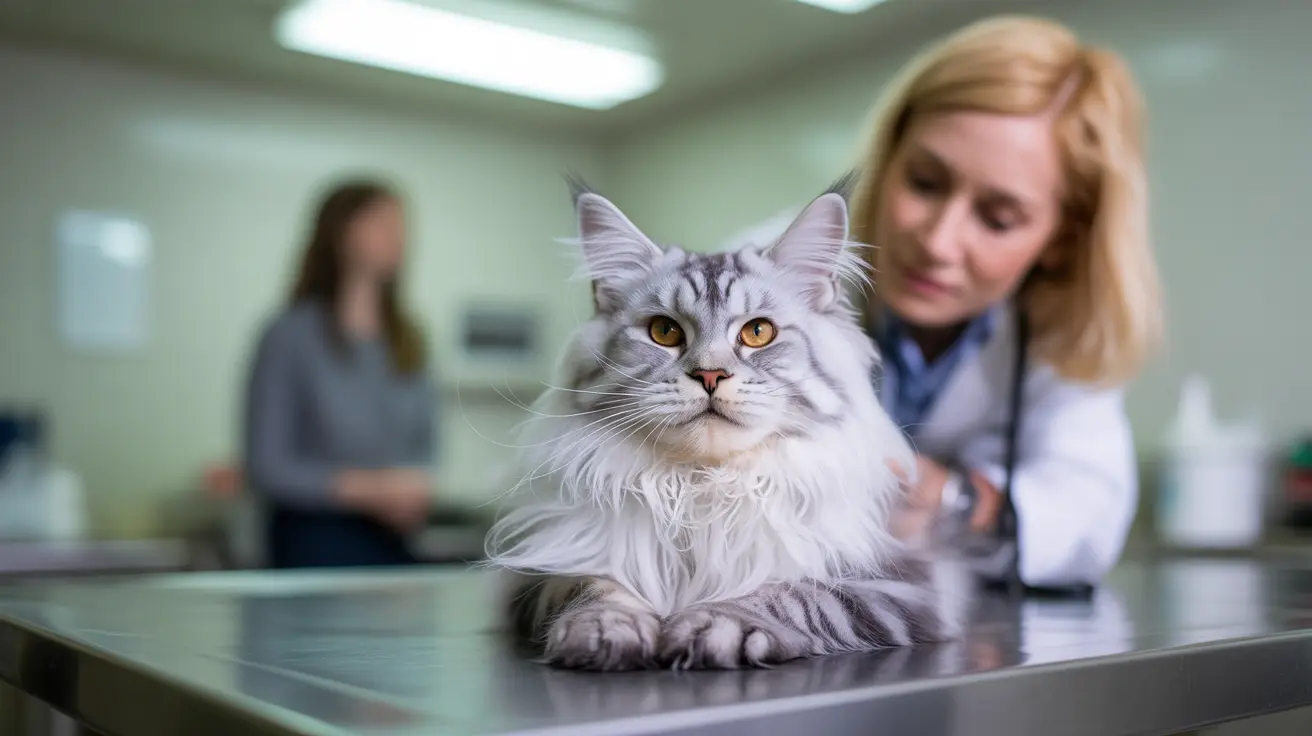How to Create a Stress-Free First Vet Visit for Your New Cat: A Complete Owner's Guide
Bringing a new cat home is an exciting milestone, but it also comes with important responsibilities—none more crucial than ensuring your feline companion receives proper veterinary care from the start. A stress-free first vet visit for your new cat sets the foundation for lifelong health and creates positive associations with medical care. Whether you've adopted from a shelter, purchased from a breeder, or welcomed a cat of unknown background, understanding how to navigate this essential appointment will benefit both you and your new pet.
This comprehensive guide will walk you through everything you need to know about preparing for and managing your cat's first veterinary visit, while also covering the important considerations for eventually introducing outdoor access. By following these expert recommendations, you'll ensure your new companion receives the best possible start in their forever home.
When to Schedule Your Cat's First Vet Visit
The timing of your new cat's first veterinary appointment depends largely on their background and source. Cats from unknown or rural backgrounds require immediate medical attention—ideally within the first few days of arrival. These cats face higher risks of parasites, diseases, and other health complications that need prompt screening and treatment.
For cats adopted from reputable shelters or breeders, you have more flexibility in scheduling. These cats typically come with some medical history and initial health screenings. However, it's still recommended to schedule a vet visit within the first week or two, allowing your cat time for initial acclimatization to their new environment while ensuring timely medical evaluation.
Remember that this first visit serves a dual purpose: confirming your cat's health status and allowing both your pet and the veterinarian to become familiar with each other. This familiarity will prove invaluable for future appointments and emergency situations.
Choosing the Right Veterinarian for Your New Cat
Selecting a veterinarian is one of the most important decisions you'll make as a new cat owner. Start by researching local veterinary practices that specialize in or have extensive experience with feline patients. Look for practices that maintain calm, cat-friendly environments and use Fear Free or similar stress-reduction protocols.
Consider factors such as location, hours of operation, emergency services availability, and staff expertise. Many successful cat owners prefer practices that offer separate waiting areas for cats and dogs, or those that schedule specific "cat-only" appointment blocks to minimize stress-inducing encounters with canine patients.
Don't hesitate to visit potential veterinary offices before making your decision. A well-organized, clean facility with knowledgeable, compassionate staff will contribute significantly to your stress-free first vet visit for your new cat and all subsequent appointments.
Preparing for the Appointment
Proper preparation is essential for ensuring a smooth veterinary visit. Schedule your appointment in advance, as this allows you to choose optimal timing and avoid rushed or emergency slots that might increase stress levels. When booking, mention that this is a first visit for a new pet, as many practices offer extended appointment times for these comprehensive initial examinations.
Gather all available medical records, including vaccination documents, previous health screenings, adoption paperwork, and any medications your cat may be taking. Even incomplete records provide valuable information that helps your veterinarian make informed decisions about your cat's care plan.
Prepare a list of questions about your cat's care, feeding requirements, behavioral concerns, and the practice's emergency services. This first appointment is an excellent opportunity to establish clear communication with your veterinary team and address any concerns you may have as a new cat owner.
Managing Stress During the Vet Visit
Your emotional state directly impacts your cat's stress level during veterinary visits. Cats are remarkably sensitive to their owner's anxiety and will often mirror these feelings. Maintain a calm, confident demeanor throughout the appointment, avoiding excessive sympathy or "pity" behaviors that can actually increase your cat's anxiety.
Speak in normal, reassuring tones and allow the veterinary staff to handle the examination professionally. Many cats respond well to gentle praise and treats during the visit, but follow your veterinarian's guidance on when and how to offer these rewards.
If your cat shows signs of extreme stress such as panting, excessive vocalization, or attempts to hide, communicate this immediately to the veterinary team. Professional staff are trained to recognize and respond to feline stress signals, often adjusting their approach or providing additional calming measures as needed.
Additional Strategies for Reducing Cat Anxiety
Consider using synthetic feline pheromone sprays in your cat's carrier and on bedding before the veterinary visit. These products can help promote calm behavior and reduce anxiety-related responses during transport and examination.
Some cats benefit from calming music designed specifically for felines, played softly during car rides to the veterinary office. Familiarize your cat with their carrier by leaving it accessible at home with comfortable bedding, treats, and toys, creating positive associations well before the appointment.
For particularly anxious cats, discuss anti-anxiety medications with your veterinarian. Some practices recommend mild sedatives for cats with extreme stress responses, though this is typically reserved for cats with documented anxiety issues or traumatic backgrounds.
Understanding Indoor Adjustment Period
Before considering any outdoor access, your new cat must complete a thorough indoor adjustment period lasting 4-6 weeks minimum. This indoor time allows your cat to establish your home as their territory, reducing the risk of them attempting to return to previous locations or simply running away when first introduced to outdoor spaces.
During this adjustment period, focus on creating a secure, enriching indoor environment. Provide multiple comfortable resting places in quiet areas, establish consistent feeding and play routines, and allow your cat to explore your home gradually at their own pace. Shy cats may require additional time and patience, sometimes hiding for several days before becoming comfortable with their new surroundings.
Monitor your cat's behavior for signs of successful adjustment, including confident exploration of living spaces, regular eating and grooming habits, and positive interactions with family members. These indicators suggest your cat is ready for the next phase of their integration into your household.
Planning Safe Outdoor Introduction
Once your cat has successfully adjusted to indoor life and completed their veterinary health screening, you can begin planning for supervised outdoor access. The key to safe outdoor introduction lies in gradual exposure and maintaining complete control over your cat's movements and environment.
Start by identifying safe outdoor spaces on your property, ideally quiet garden areas away from busy roads, loud noises, and potential hazards. The initial outdoor environment should be enclosed or easily controllable, allowing you to quickly retrieve your cat if needed.
Invest in a properly fitted harness and leash system designed specifically for cats. Unlike collars, harnesses distribute pressure safely across your cat's body and provide better control during outdoor exploration. Allow your cat to become accustomed to wearing the harness indoors before attempting outdoor adventures.
Gradual Outdoor Access Techniques
Begin outdoor introduction sessions during calm weather conditions and quiet times of day. Start with very brief exposures—perhaps just 10-15 minutes initially—allowing your cat to experience outdoor sights, sounds, and smells while remaining safely under your control.
Watch carefully for signs of stress or panic, including panting, excessive vocalization, attempts to flee, or freezing in place. If your cat displays these behaviors, calmly return them indoors immediately and try again another day with a shorter exposure time.
Gradually increase outdoor time as your cat becomes more comfortable, always maintaining leash control and staying within your designated safe area. Some cats adapt quickly to outdoor exploration, while others may require weeks or months of gradual conditioning.
Differences Between Kittens and Adult Cats
Kittens and adult cats require different approaches to outdoor introduction. Young kittens are naturally curious but lack the experience to recognize dangers, requiring more controlled and supervised outdoor access. Their smaller size also makes them more vulnerable to predators and environmental hazards.
Adult cats, particularly those with previous outdoor experience, may show stronger desires for extended outdoor exploration but also possess better judgment about potential dangers. However, adult cats from indoor-only backgrounds may need more time to adjust to outdoor stimuli and may initially find the experience overwhelming.
Regardless of age, never rush the outdoor introduction process. Each cat's timeline for comfortable outdoor access varies significantly based on personality, previous experiences, and individual stress tolerance levels.
The Importance of Spaying and Neutering
Before allowing any outdoor access, ensure your cat is spayed or neutered. These procedures significantly reduce roaming distances, decrease aggressive behaviors and fighting, and eliminate the risk of unwanted litters. Spayed and neutered cats are generally more content to stay closer to home and less likely to engage in dangerous territorial disputes.
Discuss optimal timing for spaying or neutering with your veterinarian during your first visit. Many cats can be safely altered as early as 8-12 weeks of age, though individual circumstances may affect timing recommendations.
These procedures also provide significant health benefits, reducing risks of certain cancers and eliminating heat-related stress behaviors that can complicate outdoor introduction efforts.
Microchipping and Identification
Before any outdoor access, ensure your cat has proper identification through microchipping and visible ID tags. Microchips provide permanent identification that cannot be lost or removed, significantly increasing the chances of reunification if your cat becomes lost.
Register your microchip information immediately and keep contact details current. Many veterinary practices offer microchipping services during routine appointments, making this an ideal addition to your cat's first veterinary visit.
Consider breakaway collars with current identification tags as additional visible identification. However, never rely solely on collars, as they can be lost or removed during outdoor adventures.
Creating Enriching Indoor Environments
Not all cats require or benefit from outdoor access. Many cats thrive in enriched indoor environments that provide mental stimulation, physical exercise, and environmental variety without the risks associated with outdoor roaming.
Provide multiple levels of accessible space through cat trees, shelving, and perches. Rotate toys regularly, offer puzzle feeders and interactive games, and create window viewing areas where your cat can observe outdoor activity safely.
Establish regular play sessions using interactive toys that simulate hunting behaviors. These activities help satisfy your cat's natural instincts while maintaining the safety and health benefits of indoor living.
Recognizing Signs of Stress and Adjustment Issues
Monitor your new cat carefully for signs of stress during both the initial adjustment period and any outdoor introduction phases. Common stress indicators include changes in eating habits, excessive hiding, reduced grooming, inappropriate elimination, and aggressive behaviors.
Some behavioral changes are normal during initial adjustment periods and typically resolve within a few days to weeks. However, persistent or severe behavioral issues may require veterinary consultation or professional animal behavior assistance.
Document any concerning behaviors and discuss them with your veterinarian during follow-up visits. Early intervention often prevents minor adjustment issues from developing into serious behavioral problems.
Establishing Daily Routines
Consistency in daily routines provides security and reduces stress for newly adopted cats. Establish regular feeding times, play sessions, and interaction periods that your cat can anticipate and rely upon.
Cats thrive on predictability, and established routines help them feel secure in their new environment. This sense of security is essential for successful indoor adjustment and eventual outdoor introduction, if desired.
Include grooming, medication administration (if needed), and quiet bonding time in your daily routine. These consistent positive interactions strengthen your relationship with your new cat and build the trust necessary for stress-free veterinary visits and outdoor adventures.
Frequently Asked Questions
- How soon after adoption should I schedule my cat's first vet visit?
For cats from unknown or rural backgrounds, schedule a veterinary visit within the first few days of arrival to screen for parasites and diseases. Cats from shelters or reputable breeders can wait 1-2 weeks to allow for initial acclimatization, but don't delay beyond this timeframe.
- What should I bring to my cat's first veterinary appointment?
Bring all available medical records, vaccination documents, adoption paperwork, and any medications your cat is currently taking. Also prepare a list of questions about care, feeding, and behavioral concerns you want to discuss with the veterinarian.
- How can I tell if my cat is too stressed during the vet visit?
Watch for signs like panting, excessive vocalization, attempts to hide or escape, freezing in place, or aggressive behaviors. If you notice these signs, communicate immediately with the veterinary staff, who can adjust their approach or provide additional calming measures.
- When is it safe to introduce my new cat to outdoor access?
Wait at least 4-6 weeks after bringing your cat home to allow for complete indoor adjustment. Your cat should be comfortable exploring your home, eating regularly, and interacting positively with family members before considering outdoor introduction.
- Is it necessary to spay or neuter my cat before outdoor access?
Yes, spaying or neutering is highly recommended before allowing outdoor access. These procedures reduce roaming distances, decrease fighting behaviors, and eliminate the risk of unwanted litters, making outdoor exploration safer for your cat.
- How do I know if my cat is ready for outdoor introduction?
Your cat should demonstrate confident indoor behavior, regular eating and grooming habits, positive interactions with family members, and comfort with wearing a harness indoors. They should also be current on vaccinations and parasite prevention as confirmed by your veterinarian.
- What if my cat shows extreme anxiety during outdoor introduction attempts?
If your cat exhibits signs like panting, freezing, or attempts to flee, immediately return them indoors and try again another day with shorter exposure times. Some cats may never be comfortable with outdoor access, and that's perfectly acceptable—focus on creating an enriched indoor environment instead.
Conclusion
Successfully managing your new cat's first veterinary visit and potential outdoor introduction requires patience, preparation, and understanding of your feline companion's individual needs. By following these guidelines for creating a stress-free first vet visit for your new cat, you're establishing a foundation for lifelong health and happiness. Remember that every cat adjusts at their own pace, and there's no need to rush any phase of the integration process.
The investment you make in proper veterinary care and thoughtful environmental introduction will pay dividends throughout your cat's life. Whether your feline friend becomes an indoor-only companion or enjoys supervised outdoor adventures, the key lies in prioritizing their physical health, emotional well-being, and safety above all else. Trust the process, maintain open communication with your veterinary team, and enjoy the rewarding journey of welcoming your new cat into their forever home.






